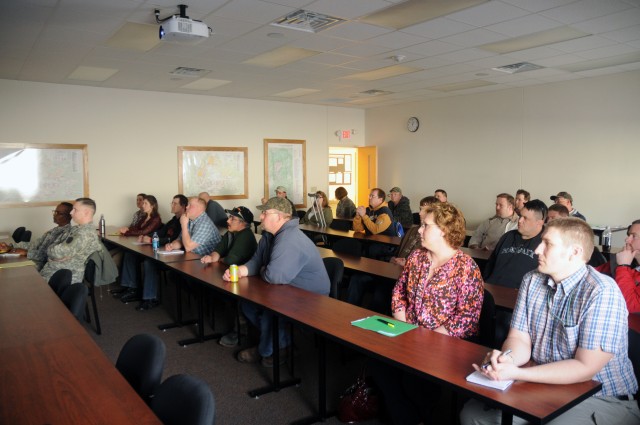FORT McCOY, Wis. -- The advent of spring and summer at Fort McCoy brings an increased risk of tornadoes, hail, thunderstorms and high winds.
Fort McCoy personnel who attended weather-spotter training March 21 at the installation are helping to lay the groundwork for increased safety of the Fort McCoy Soldier, Family and Civilian community.
Quentin Graham, Emergency Management specialist for the Fort McCoy Directorate of Plans, Training, Mobilization and Security (DPTMS), said the training presented by the National Weather Service (NWS) will help installation Emergency Management support personnel react to and issue warnings about impending severe weather.
"We wanted to get information about severe weather into the hands of individuals who could help protect the Fort McCoy community," Graham said. "More than half of individuals attending were from either the Directorate of Emergency Services (DES) or DPTMS Range Control. "
"They would be the most likely individuals out in the field who are equipped to report severe weather conditions. It is important that our initial spotters are trained to report timely and accurate weather information to the Directorate of Emergency Services 24/7 Dispatch center in order to sound the External Mass Warning and Notification system and notify DPTMS Range Control for troops in the field."
Severe weather can affect many of the activities outside that occur at Fort McCoy in the spring and summer months, such as training, construction or other field work, Graham said.
Troops often have or use metal objects, such as communications equipment, during their training.
Being able to turn off or quickly disassemble the equipment in advance of severe weather can increase troop safety.
Robert Nordby of the Fort McCoy DES said several members of the installation's police department attended the training because the department provides a 24/7 presence patrolling the installation.
"They serve as our eyes and ears at all times during the day," Nordby said. "The officers are not only looking for 'bad' guys, they are looking out for the safety of the community. When you have well-trained officers, they can recognize bad weather is coming and get the word out, not only to the work force in the cantonment area, but out to those training in the field."
Tim Caucutt of DPTMS Range Control said he attended the training because he works with units in the field and wants to help ensure their safety during training.
"We can use the information from the course to help determine if we are getting false calls about the weather," Caucutt said. "We can inform the units in the field about the deteriorating weather conditions."
Tim Halbach, a meteorologist with NWS at La Crosse, presented the program. His presentation illustrated the weather conditions the spotters might observe and explained how human input remains vital to the overall effectiveness of the system, which includes the use of radar to help predict the weather, he said.
"We provide a lot of courses at this time of year to help prepare for the severe-weather season," Halbach said. "We might see something on the radar, but having 'eyes' on the ground helps us calibrate or validate what we're seeing."
For example, the radar might pick up a hail storm in progress, but that doesn't always give complete details about the storm's severity, Halbach said.
Weather spotters on the ground can have a great deal of influence on what is reported/recommended, if they observe one-half inch diameter or golf-ball size hail is occurring, and can relay that information to the NWS, he said.
"The main thing is that we want to save lives," Halbach said. "We want people to call and tell us what's happening, so that we can put out an advance warning."
For more information about the weather-spotters training in the Fort McCoy community, contact Graham at 608-388-2763.
For more information about the NWS or weather-spotter classes, visit the websites www.weather.gov or http://www.stormready.noaa.gov/contact.htm.


Social Sharing